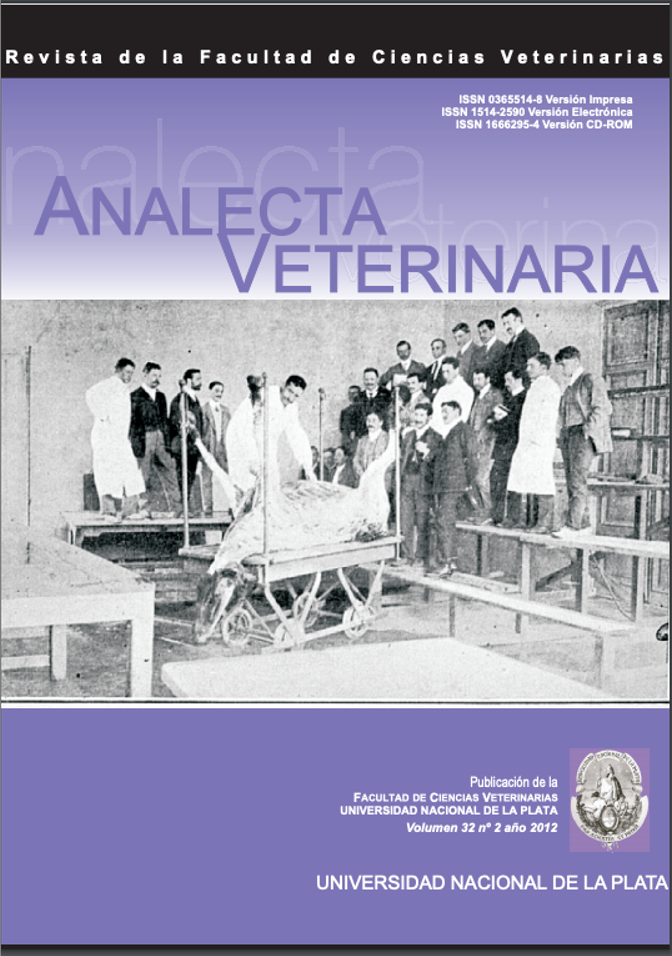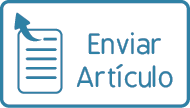Penetración de fosfomicina en explantes intestinales
Palabras clave:
Fosfomicina, Deoxinivalenol, Explantes intestinales, CerdosResumen
Fosfomicina (FOS) es un antibiótico utilizado en producción porcina para el tratamiento y prevención de infecciones causadas por bacterias resistentes durante el post destete. En la dieta de los animales es frecuente encontrar antibióticos y concentraciones subtóxicas de micotoxinas como el deoxinivalenol (DON). Estos compuestos pueden establecer interacciones en el tracto intestinal afectando y/o modificando la penetración de FOS a los enterocitos. El objetivo de este trabajo fue desarrollar un cultivo de explantes de intestino procedentes de yeyuno de cerdos y aplicar este modelo para estudiar la penetración intracelular de FOS en presencia o ausencia de DON. El uso de explantes intestinales disminuye el sacrificio de animales por experimento y preservan la estructura histológica intestinal normal en condiciones in vitro. Los resultados mostraron que no existieron diferencias estadísticamente significativas en la concentración intracelular de FOS entre los explantes incubados con 580 ppm FOS y los explantes incubados con 580 ppm FOS y 1 ppm DON. Se obtuvo un Cmax de 12 ppm y tmax de 2 h. Nuestro estudio demostró que solo el 2% del antibiótico se acumula intracelularmente y que la concentración intracelular de FOS no es afectada por la presencia de concentraciones subtóxicas de DON.
Referencias
Mata J, Rodriguez A, Gallego A. Fosfomycin: in vitro activity. Chemotherapy 1977; 23 (suppl l): 23–24.
Kahan FM, Kahan JS, Cassidy PJ, Kropp H. The mechanism of action of fosfomycin (phosphonomycin). Ann NY Acad Sc 1974; 235: 364–386.
Popovic M, Steinort D, Pillai S, Joukhadar C. Fosfomycin: an old, new friend? Eur J Clin Microbiol Infect Dis 2010; 29 (2): 127–142.
Gobernado M. Fosfomicina. Rev Esp Quimioter 2003; 16 (1): 15-40.
Gallego A, Rodriguez A, Mata JM. Fosfomycin: pharmacological studies. Drugs Today 1974; 10:161–168.
Aramayona JJ, Bregante MA, Solans C, Rueda S, Fraile LJ, Garcia MA. Pharmacokinetics of fosfomycin in chickens after a single intravenous dose and tissue levels following chronic oral administration. Vet Res 1997; 28 (6): 581–588.
Carraminana JJ, Rota C, Agustin I, Herrera A. High prevalence of multiple resistance to antibiotics in Salmonellae serovars isolated from a poultry slaughterhouse in Spain. Vet Microbiol 2004; 104: 133-139.
Borsa F, Leroy A, Fillastre JP, Godin M, Moulin B. Comparative pharmacokinetics of tromethamine fosfomycin and calcium fosfomycin in young and elderly adults. Antimicrob Agents Chemother 1988; 32: 938-941.
Patel SS, Balfour JA, Bryson HM. Fosfomycin tromethamine. A review of its antibacterial activity, pharmacokinetic properties and therapeutic efficacy as a single-dose oral treatment for acute uncomplicated lower urinary tract infections. Drugs, 1997; 53: 637-656.
Soraci AL, Perez DS, Martinez G, Dieguez S, Tapia MO, Amanto F, Harkes R, Romano O. Disodium-fosfomycin pharmacokinetics and bioavailability in post weaning piglets. Res Vet Sci 2011; 90: 498-502.
Pakhomova S, Bartlett S, Augustus A, Kuzuyama T, Newcomer M. Crystal structure of fosfomycin resistance kinase FomA from Streptomyces wedmorensis. J Biol Chem. 2008; 283(42): 28518-26.
Dirkzwager A, Veldman B, Bikker P. A nutritional approach for the prevention of post weaning syndrome in piglets. Anim Res 2005; 54: 231-236.
Soraci AL, Amanto F, Hartes R, Pérez D, Martínez G, Diéguez SN, Tapia MO. Uso estratégico de aditivos: impacto sobre el equilibrio y salud gastrointestinal del lechón. Analecta Vet 2010; 30 (1): 42-53.
Nabuurs MJA. Weaning piglets as a model for studying pathophysiology of diarrhea. Vet quart 1998; 20 (3): 42-45.
Lawlor P, Brendan Lynch P. Mycotoxins in pig feeds 2: clinical aspects. Ir Vet J 2001; 54 (4): 172-176.
Pestka JJ. Deoxynivalenol: toxicity, mechanisms and animal health risks. Anim Feed Sci Technol 2007;137: 283–298.
Rotter BA, Thompson BK, Lessard M, Trenholm HL, Tryphonas H. Influence of low-level exposure to Fusarium mycotoxins on selected inmunological and hematological parameters in young swine. Fund Appl Toxicol 1994; 23: 117-124.
Nietfeld JC, Tyler DE, Lenn RH, Cole JR, Latimer KS, Wayne AC. Culture and morphologic features of small intestinal mucosal explants from weaned pigs. A J Vet Res 1991; 52 (7): 1142-1146.
Kolf-Clauw M, Castellote J, Joly B, Bourges-Abella N, Raymond-Letron I, Pinton P, Oswald I. Development of a pig jejunal explant culture for studying the gastrointestinal toxicity of the mycotoxin deoxynivalenol: Histopathological analysis. Toxicol in Vitro 2009; 23:1580–1584.
Zhu Ch, Harel J, Jacques M, Fairbrother JM. Interaction with pig ileal explants of Escherichia coli 045 isolates from swine with postweaning diarrhea. Can J Vet Res 1995; 59: 118-123.
Ruckebusch Y. Physiologie Pharmacologie Therapeutique animals. 2nd. Ed. Maloine S.A., 1981.
Isengard HD. Rapid water determination in foodstuffs. Trends in Food Science & Technology 1995; 6 (5): 155–162.
Danielsen EM, Sjöström H, Norén O, Bro B, Dabelsteent E. Biosynthesis of intestinal microvillar proteins. Biochem J 1982; 202: 647-654.
German AJ, Hall EJ, Day MJ. Relative deficiency in IgA production by duodenal explants from German shepherd dogs with small intestinal disease. Vet Immunol Immunopathol 2000; 76: 25–43.
Höger PH, Seger RA, Schaad UB, Hitzig WH. Chronic granulomatous disease: uptake and intracellular activity of fosfomycin in granulocytes. Pediatr Res 1985; 19 (1): 38-44.
Goyarts T, Dänicke S. Bioavailability of the Fusarium toxin deoxynivalenol (DON) from naturally contaminated wheat for the pig. Toxicol Lett 2006;163 (3): 171–182.
Awad WA, Aschenbach JR, Setyabudi FMCS, Razzazi-Fazeli E, Böhm J, Zentek J. In vitro effects of Deoxynivalenol on small intestinal D -glucose uptake and absorption of Deoxynivalenol across the isolated jejunal epithelium of laying hens. Poult Sci 2007; 86:15–20.
Maresca M, Mahfoud R, Garmy N, Fantini J. The mycotoxin deoxynivalenol affects nutrient absorption in human intestinal epithelial cells. J Nutr 2002; 132: 2723–2731.
Descargas
Publicado
Número
Sección
Licencia
Los autores/as conservan los derechos de autor y ceden a la revista el derecho de la primera publicación, con el trabajo registrado con la licencia de atribución de Creative Commons, que permite a terceros utilizar lo publicado siempre que mencionen la autoría del trabajo y a la primera publicación en esta revista.

Analecta Veterinaria por Facultad de Ciencias Veterinarias se distribuye bajo una Licencia Creative Commons Atribución-NoComercial-SinDerivar 4.0 Internacional.




























